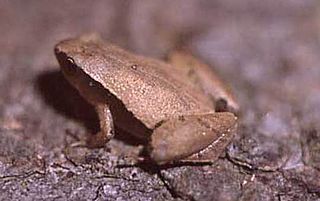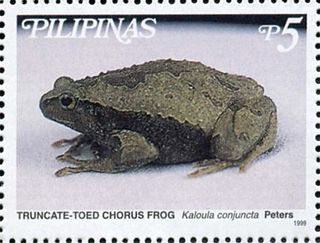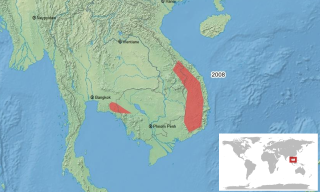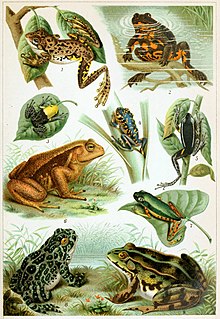
A marsh is a wetland that is dominated by herbaceous rather than woody plant species. Marshes can often be found at the edges of lakes and streams, where they form a transition between the aquatic and terrestrial ecosystems. They are often dominated by grasses, rushes or reeds. If woody plants are present they tend to be low-growing shrubs. This form of vegetation is what differentiates marshes from other types of wetland such as swamps, which are dominated by trees, and mires, which are wetlands that have accumulated deposits of acidic peat.

Microhyla is a group of frogs, commonly known as the rice frogs or narrow-mouthed frogs. It is a genus within the family Microhylidae and consists of a number of diminutive frogs. Members of this genus are widespread from Ryukyu Is. in Japan, China throughout South-east Asia, Sumatra, Java, Bali, Borneo, India and Sri Lanka. As of 13 March 2016, there were 40 species in this genus,
The spotted betta or Java fighting fish is a species of gourami endemic to Indonesia where it inhabits relatively cool, 22‒25 °C (72‒75 °F), highland streams of Java and Sumatra. In 1967, D. S. Johnson reported the species to be common in blackwaters of southern Malaya.

Microhyla berdmorei is a species of narrow-mouthed frog found in eastern India, Bangladesh, southernmost China (Yunnan), Mainland Southeast Asia as well as Borneo and Sumatra. Frogs from Bangladesh probably represent an unnamed species.

Microhyla heymonsi is a species of narrow-mouthed frog found in northeastern India, southern China, Taiwan, and Southeast Asia south to the Malay Peninsula and Sumatra as well as the Great Nicobar Island. It was originally described from Taiwan.

The painted tree frog is a species of frog in the family Hylidae found in Belize, Guatemala, Honduras, and Mexico. Its natural habitats are subtropical or tropical dry forests, subtropical or tropical moist lowland forests, freshwater marshes, intermittent freshwater marshes, pastureland, plantations, rural gardens, heavily degraded former forests, ponds, and canals and ditches.

The Philippine narrowmouth toad or the truncate-toed chorus frog is a species of frog in the family Microhylidae. It is endemic to the Philippines. Its natural habitats are subtropical or tropical dry forests, subtropical or tropical moist lowland forests, subtropical or tropical moist shrubland, subtropical or tropical seasonally wet or flooded lowland grassland, rivers, intermittent rivers, freshwater lakes, intermittent freshwater lakes, freshwater marshes, intermittent freshwater marshes, arable land, pastureland, plantations, rural gardens, heavily degraded former forest, water storage areas, ponds, irrigated land, and seasonally flooded agricultural land. It is threatened by habitat loss.

The painted narrowmouth toad or slender-digit chorus frog is a species of frog in the family Microhylidae.

Microhyla annamensis is a species of frog in the family Microhylidae. It is found in Cambodia, Laos, Thailand, and Vietnam. Its natural habitats are subtropical or tropical moist lowland forests, subtropical or tropical moist montane forests, swamps, and intermittent freshwater marshes.
Microhyla borneensis, also known as the Matang narrow-mouthed frog, is a species of microhylid frog found in the Matang Range in Sarawak, Borneo. It was once the smallest known frog from the Old World. Adult males of this species have a snout-vent length (SVL) of 10.6–12.8 mm (0.42–0.50 in),but adult males can reach a maximum of 13 mm (0.51 in),and adult females of this species have a snout-vent length of 16–19 mm (0.63–0.75 in), Tadpoles measure just 3 mm.

The painted chorus frog is a species of frog in the family Microhylidae. It is found in northeast India, Myanmar, southern China, Hong Kong, Taiwan, Thailand, Cambodia, Laos, Vietnam, Peninsular Malaysia, and Singapore. Its natural habitats are subtropical or tropical moist lowland forest, subtropical or tropical moist montane forest, subtropical or tropical moist shrubland, swamps, intermittent freshwater marshes, arable land, plantations, rural gardens, ponds, open excavations, and irrigated land. It is not considered threatened by the IUCN.

The Mada paddy frog is a species of frog in the family Microhylidae. It is known from Myanmar, Thailand, and Vietnam. Its natural habitats are swamps, freshwater marshes, and intermittent freshwater marshes. While formerly classified in the genus Microhyla, a 2018 study found it to belong to the genus Micryletta instead. A study performed in 2019 found that several Micryletta populations in southern Myanmar and Thailand that were formerly assigned to M. inornata actually belong to M. erythropoda; prior to this, M. erythropoda was considered endemic to Vietnam.
Microhyla fusca is a species of frog in the family Microhylidae. It is endemic to Vietnam: it is only known from its type locality, Da Lat on Lang Biang Plateau in southern Vietnam. Its natural habitats are swamps, freshwater marshes, and intermittent freshwater marshes. Its status is insufficiently known.
The mixtured pygmy frog is a species of frog in the family Microhylidae. It is endemic to China. Its natural habitats are temperate grassland, subtropical or tropical dry lowland grassland, rivers, intermittent freshwater marshes, and irrigated land. It is not considered threatened by the IUCN.

The palmated chorus frog is a species of frog in the family Microhylidae. It is found in Indonesia and Malaysia. Its natural habitats are subtropical or tropical moist lowland forests, rivers, and freshwater marshes. It is not considered threatened by the IUCN.
Microhyla perparva is a species of frog in the family Microhylidae. It is found in Indonesia and Malaysia. Its natural habitats are subtropical or tropical moist lowland forests and intermittent freshwater marshes. It is threatened by habitat loss.
Microhyla zeylanica. the Sri Lanka rice frog or Sri Lanka narrow-mouth frog, is a species of frog in the family Microhylidae. It is endemic to Sri Lanka. Its natural habitats are subtropical or tropical moist montane forests, subtropical or tropical high-altitude grassland, swamps, freshwater marshes, and intermittent freshwater marshes. It is threatened by habitat loss.
The spotted rocksnail, scientific name Leptoxis picta, is a species of freshwater snail with a gill and an operculum, an aquatic gastropod mollusk in the family Pleuroceridae. This species is endemic to the United States.

A freshwater marsh is a marsh that contains fresh water. Freshwater marshes are usually found near the mouths of rivers and are present in areas with low drainage. It is the counterpart to the salt marsh, an upper coastal intertidal zone of bio-habitat which is regularly flushed with sea water.















